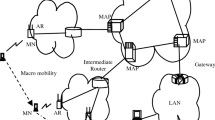Abstract
Mobile IPv6 (MIPv6) is extended to Hierarchical MIPv6 (HMIPv6) by introducing a Mobile Anchor Point (MAP) between home agent (HA) and the mobile node’s (MN’s) temporary location. The MAP acts as a coordinator of the MN and reduces signaling cost for handoff management. It also reduces handoff latency suffered by MN. However, the MAP in the HMIPv6 architecture is a single point of failure, as all packets from any correspondent node (CN) goes via the MAP. In this paper, a thorough analysis of the MAP performance in terms of packet loss probability, packet blocking probability and end-to-end delay is presented. Three classes of users, namely Thin, Normal and Fat, are identified based on the amount of packets transmitted per second by the user. From the analysis carried out in this paper, we wanted to examine the volume users in different classes, i.e., Thin, Normal and Fat that can be supported by a single MAP under its coverage without deteriorating the quality of service (QoS) to the end users. A scheme for selecting an alternative MAP by an MN (MAP selection algorithm) is proposed here in order to preserve the QoS to the end users under the circumstances when the current MAP is unable to satisfy the need of the newly arriving MN. The proposed algorithm named as User-Centric MAP Selection (UCMS) is compared with existing similar protocol, Adaptive Overload Prevention (AOP). Observation shows that UCMS performs better in selecting a new MAP.










Similar content being viewed by others
References
George W, Donley C, Liljenstolpe C, Howard L (2012) IPv6 support required for all IP-capable nodes, RFC 6540
Postel J (1981) Internet protocol, RFC 791
Deering S, Hinden R (1998) Internet protocol version 6 (IPv6) specification, RFC 2460
Johnson D, Perkins C (2004) Mobility support in IPv6, RFC 3775
Soliman H, Castelluccia C, El-Malki K, Bellier L (2005) Hierarchical MIPv6 mobility management (HMIPv6), RFC 4140
Pack S et al (2004) A study on optimal hierarchy in multi-level hierarchical mobile IPv6 networks. In: Proceedings of IEEE Globecom, Texas, USA
Das S, Misra A, Agrawal P, Das SK (2000) TeleMIP: telecommunications-enhanced MIPv4 architecture for fast intradomain mobility. IEEE Pers Commun 7:50–58
Han Y-H, Min S-G (2009) Performance analysis of hierarchical mobile IPv6: Does it improve mobile IPv6 in terms of handover speed? Wireless Pers Commun 48(4):463–483
Wang K, Yu S (2010) LT-TMAP fast handover scheme on improved HMIPv6. Comput Des Appl 1:1–4
Chung WS, Kim M-S, Mo JH, Lee SK (2012) QoS-aware dynamic MAP selection schemes in HMIPv6 networks. J Parallel Distrib Comput 72(7):838–855
Wan Z, Pan X, Chen J, Cui Y (2006) A three-level mobility management scheme for hierarchical mobile IPv6 networks. J Zhejiang Univ Sci A 7(12):2118–2126
Zakaria MS, Kusin Z (2012) Experimental framework for mobility anchor point selection scheme in hierarchical mobile IPv6. ACEEE Int J Netw Secur 3(1):29–33
Kadusic E, Zivic N, Kos A (2016) QoS-aware dynamic MAP selection in HMIPv6 architect. IEEE Access 4:3112–3126
Chiang M-S, Huang C-M, Dao D-T, Pham B-C (2017) GB-PMIPv6: a group-based handover control scheme for PMIPv6 using the ‘hitch on’ concept. Comput J 60(6):822–834
Kadusic E, Zivic N, Skrbic M, Hadzialic M, Behlilovic N (2015) Euclidean distance-based QoS metric for dynamic MAP selection in HMIPv6 network. In: IEEE international conference on computer and information technology; ubiquitous computing and communications; dependable, autonomic and secure computing; pervasive intelligence and computing, Liverpool, UK, pp 354–358
Tao M, Yuan H, Wei W (2014) Active overload prevention based adaptive MAP selection in HMIPv6 networks. Wirel Netws 20(2):197–208
Agarwal DP, Zeng Q-A (2004) Introduction to wireless and mobile communication systems, 2nd edn. Thomson, Singapore
Banks J, Carson JS, II, Nelson BL, Nicol DM (2004) Discrete-event system simulation, Pearson Education, London. ISBN 81-7808-505-4
Dshalalow JH (1993) On applications of little’s formula. J Appl Math Stoch Anal 6(3):271–276
Peng X, Zhang H, Hu J, Zhang S (2003) Modeling in hierarchical mobile IPv6 and intelligent mobility management scheme. In: Proceedings of 14th IEEE international symposium on personal, indoor and mobile radio communication, Beijing, China, pp 2823–2827
Grewal BS (2012) Higher engineering mathematics, 42nd edn. Khanna Publishers, Delhi
Orebaugh A, Ramirez, G, Beale J (2007) Wireshark& Ethereal network protocol analyzer toolkit Syngress, Rockland p 448. ISBN 1-59749-073-3
Soliman H (2004) Mobile IPv6 mobility in a wireless Internet. Pearson Education, London
Author information
Authors and Affiliations
Corresponding author
Additional information
Publisher's Note
Springer Nature remains neutral with regard to jurisdictional claims in published maps and institutional affiliations.
Rights and permissions
About this article
Cite this article
Dutta, N., Sarma, H.K.D. A Scheme for Dynamic MAP Selection in HMIPv6. Proc. Natl. Acad. Sci., India, Sect. A Phys. Sci. 90, 371–382 (2020). https://doi.org/10.1007/s40010-018-0579-2
Received:
Revised:
Accepted:
Published:
Issue Date:
DOI: https://doi.org/10.1007/s40010-018-0579-2




